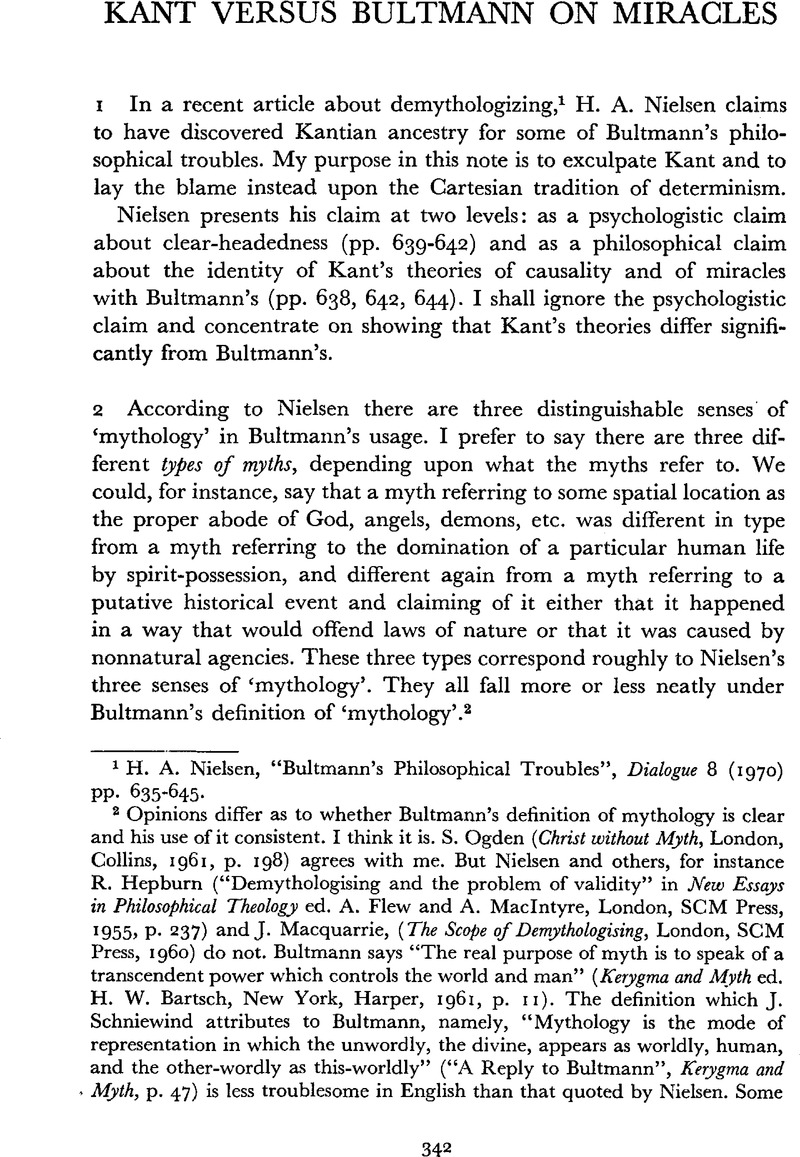No CrossRef data available.
Article contents
Kant Versus Bultmann on Miracles
Published online by Cambridge University Press: 01 June 1971
Abstract

- Type
- Notes—Discussion
- Information
- Dialogue: Canadian Philosophical Review / Revue canadienne de philosophie , Volume 10 , Issue 2 , June 1971 , pp. 342 - 346
- Copyright
- Copyright © Canadian Philosophical Association 1971
References
1 Nielsen, H. A., “Bultmann's Philosophical Troubles”, Dialogue 8 (1970) pp. 635–645CrossRefGoogle Scholar.
2 Opinions differ as to whether Bultmann's definition of mythology is clear and his use of it consistent. I think it is. S. Ogden (Christ without Myth, London, Collins, 1961, p. 198) agrees with me. But Nielsen and others, for instance R. Hepburn (”Demythologising an d the problem of validity” in New Essays in Philosophical Theology ed. A. Flew and A. Maclntyre, London, SCM Press, 1955, p. 237) and J. Macquarrie, (The Scope of Demythologising, London, Press, 1960) do not. Bultmann says “The real purpose of myth is to speak of a transcendent power which controls the world and man” (Kerygma and Myth ed H. W. Bartsch, New York, Harper, 1961, p. 11). The definition which J. Schniewind attributes to Bultmann, namely, “Mythology is the mode of representation in which the unwordly, the divine, appears as worldly, human, and the other-wordly as this-worldly” (“A Reply to Bultmann”, Kerygma and Myth, p. 47) is less troublesome in English than that quoted by Nielsen. Some of Nielsen's worries are clearly beside the point when the two quotations here are taken to define mythology.
3 In the Bible, ‘miracle’ is used to translate Hebrew and Greek words with the primary senses of ‘signal’, ‘sign’, ‘wonder’, ‘mighty work’.
4 The Leibniz-Clarke Correspondence, ed. H. G. Alexander (Manchester, Manchester University Press, 1956) pp. 20–22.
5 Hume. An Enquiry concerning Human Understanding. Section X.
6 Newton, Opticks Query 31; Laplace, A Philosophical Essay on Probabilities (trans. F. Truscott and F. Emory, New York, Dover, 1951) p. 4.
7 See R. Bultmann, Jesus Christ and Mythology (London, SCM Press, 1958) p. 15, p. 38, pp. 64–66; Existence and Faith (New York, Meridian, 1961) pp. 291–2; Kerygma and Myth, pp. 103, 109.
8 Schleiermacher, On Religion, Speeches to its Cultured Despisers (trans. J. New York, Harper, 1958) esp. p. 88. Compare P. Tillich, Systematic Theology, I, (London, Nisbet, 1953) p. 130.
9 Bultmann does not, like Leibniz and Laplace, hold tenaciously to the view that the world is orderly; in a paradoxical fashion, he claims that in faith he denies this closed connection: “I deny the worldly connection of events when I spea k of myself, for in this connection of worldly events, my self, my personal existence, my own personal life, is no more visible and capable of proof than is God as acting” (Jesus Christ and Mythology, p. 65). However, Bultmann's existentialist rejection of the truth of the determinist world-picture is not in the same class as Kant's claim that the deterministic world-picture is phenomenal. For Bultmann, the obligation to deny what he regards as the scientific world-view is “the paradox of faith”.
10 Kant, Religion within the limits of reason alone (trans. T. M. Greene and H. H. Hudson, New York, Harper, 1960) pp. 82–3.
11 As Leibniz said in his second letter to Clarke: “recourse to miracles in order to explain natural things … is reducing an hypothesis ad absurdum: for, everything may easily be accounted for by miracles” (para 12).


